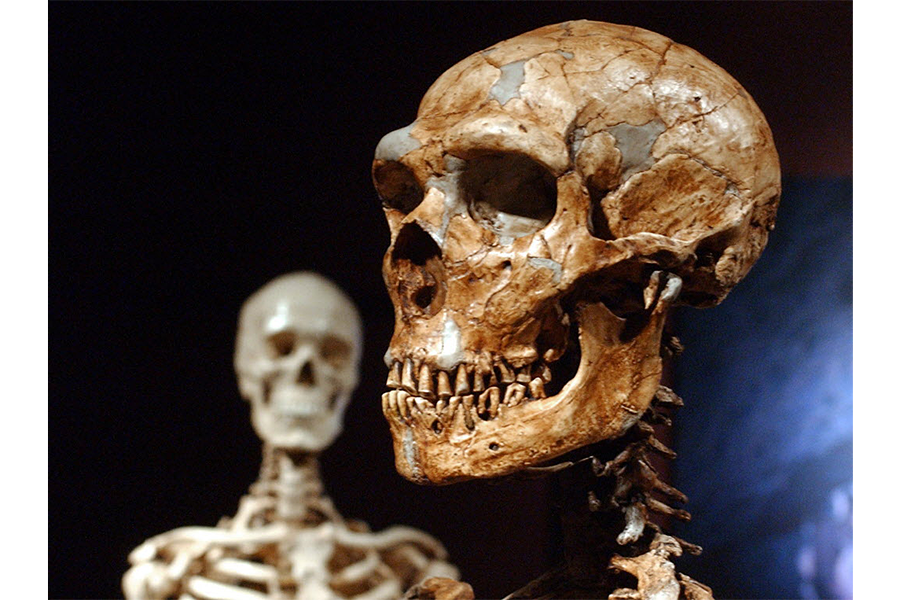Why don't humans have more Neanderthal DNA?
Loading...
In humanity's distant past, perhaps as early as 100,000 years ago, anatomically modern humans who had migrated out of Africa encountered a close human relative: the Neanderthal. The two populations interbred, leaving traces in the genomes of non-African humans alive today, such that 1 to 4 percent of the human genome is Neanderthal genetic material.
Our only knowledge of how these two human lineages interacted over tens of thousands of years is written in our genomes. But scientists have found that parts of the modern human genome are mysteriously lacking in Neanderthal ancestry, suggesting that natural selection had favored the anatomically modern human genetics over that of the archaic humans.
But why? To find out, a team of evolutionary geneticists from the University of California, Davis dug into the DNA to determine if the Neanderthal genetic material that has since disappeared in anatomically modern humans was particularly disadvantageous for hybrids.
And it turns out, the Neanderthal DNA probably didn't cause major problems for its owners. Instead, in the context of the larger population size of anatomically modern humans, slightly disadvantageous genetics that had stuck around in the relatively smaller Neanderthal population were slowly selected out in the hybrids, they report in a paper published Tuesday in the journal PLOS Genetics.
"We've known for a number of years that Neanderthals had very small population sizes," study senior author Graham Coop, a geneticist at the University of California, Davis, tells The Christian Science Monitor in a phone interview. Because the populations were small, the Neanderthals ended up interbreeding with distant relatives more often and the gene pool preserved some slightly disadvantageous genetic variations.
"Anything that was really disadvantageous would have been very quickly wiped out but there is this sort of sweet spot, or not-so-sweet spot," where the genetic variation could persist, Dr. Coop explains. So when anatomically modern humans and Neanderthals met and interbred, these weakly deleterious sequences would have been passed along to the hybrids. But in that larger population of humans, perhaps five times larger, Coop says, those sequences could have been purged more readily than in the small Neanderthal populations.
"One of the things that's really interesting here is that if Neanderthals had had a larger population size or humans had had a smaller population size, we might have ended up with a lot more Neanderthal genome in our modern genomes," Coop says.
The power of population size in natural selection "makes a lot of intuitive sense," Adam Siepel, a computational biologist at Cold Spring Harbor Laboratory who was not part of this research, writes in an email to the Monitor. "It nicely explains the deficit of Neanderthal-derived segments near genes and other known functional elements, and provides an explanation for why this effect is distributed across the genome rather than driven by a few regions that might have been under strong selection."
That said, he adds, estimating the strength of selection across the genome rather than in specific sites is a difficult task and requires some simplifying assumptions. Still, Dr. Siepel says, "overall I think they do a good job of arguing that the selection must be weak."
This team of researchers wasn't the first to suggest that relative population sizes had something to do with the selection against Neanderthal DNA in hybrids. Geneticists Kelley Harris and Rasmus Nielsen came to similar conclusions in a paper published earlier this year.
"The [new] paper provides additional evidence that there has been selection in humans against Neanderthal DNA," Dr. Nielsen, researcher at the Center for Theoretical Evolutionary Genomics at the University of California, Berkeley, writes in an email to the Monitor, "not because Neanderthals and humans were incompatible genetically as you would expect if humans and Neanderthals were different species – but rather because Neanderthals had a very small population size and therefore had a lot on inbreeding resulting in an accumulation of slightly deleterious mutations."
So does this suggest that Homo sapiens and Neanderthals were actually the same species?
"What a species is is a somewhat subjective question," Coop says, especially when talking about something that is only known from the fossil record.
One distinction that is often made is whether animals can interbreed and produce fertile offspring – which, apparently, H. sapiens and Neanderthals did – but the scientists are hesitant to say they were indeed the same species.
"Certainly our work shows that there was potentially no large incompatibilities between the two" when they interbred, Coop says.
As more and more research suggests Neanderthals were quite sophisticated and like modern humans, one often posed question has been why did H. sapiens survive but the archaic humans did not.
Nielsen says, based on his own research, it seems like "the Neanderthals never went extinct - they just simply got absorbed into the human species … Neanderthals were not driven to extinction by competition with humans - or by warfare with humans. Rather they disappeared by simply slowly interbreeding with humans and by becoming part of the human species."
But Coop and study lead author Ivan Juric, who was working in Coop's lab during the study but is now at 23andMe, Inc., aren't comfortable making that leap from their research.
"We tell a story about what happened to Neanderthal DNA that got into modern humans, and that story does not tell much about why Neanderthals might have gone extinct and we did not," Dr. Juric writes in an email to the Monitor.
And it's unlikely that disadvantageous DNA that was selected against in the modern human-Neanderthal hybrids pushed the archaic humans to their demise, Coop says. "Neanderthals managed to persist for hundreds of thousands of years in really rough conditions so I don't think these weakly deleterious gene variants were really doing them that much harm."








